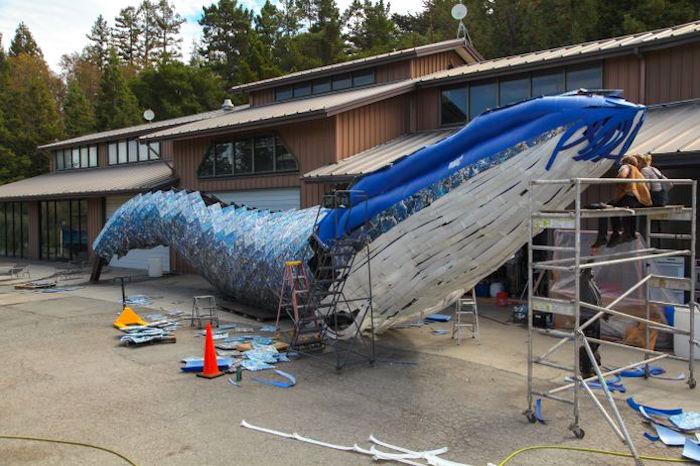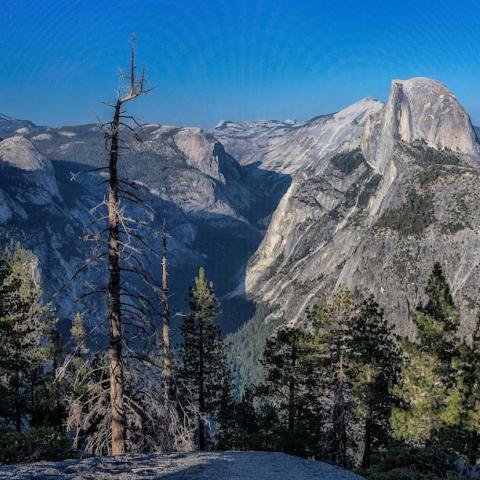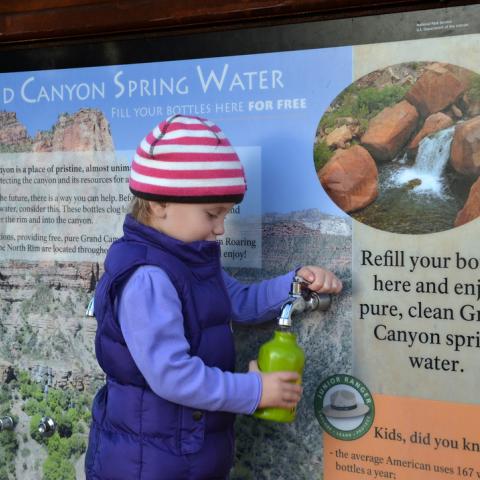
Artists Joel Dean Stockdill and Yustina Salnikova sit atop scaffolding at the construction site of Monterey Bay Aquarium's life-sized blue whale art installation made from discarded single-use plastic/Monterey Bay Aquarium
It will tower above Crissy Field at Golden Gate National Recreation Area, an 82-foot-long big, blue statement to the extent of plastics pollution in the world's oceans.
Designed with help from the Monterey Bay Aquarium, the National Park Service, and the Golden Gate National Parks Conservancy, the life-sized blue whale art installation at the heart of Crissy Field in the Presidio aims to bring awareness to a massive problem: the issue of ocean plastic pollution. The blue whale made from hand-recycled plastic trash makes a splash on Saturday and will remain on public view there for three months, until January 2019.
Monterey Bay Aquarium chose the endangered blue whale as the subject of the art installation to draw a connection between plastic pollution and its impact on marine life around the world. The largest animal ever to live on Earth, a blue whale can weigh about 300,000 pounds – the approximate weight of plastic that ends up in the ocean every nine minutes.
“We created a life-sized blue whale to dramatize the scale of the problem,” said Julie Packard, executive director of the aquarium. “As people view the installation, we hope they’re inspired to make changes in their own plastic consumption and will to join us in protecting ocean wildlife.”
Bay Area artist Joel Dean Stockdill, known for creating artworks from reclaimed materials, collaborated with co-creator Yustina Salnikova to build the blue whale installation. The two, along with a team, personally hand-sorted, cleaned, and cut plastic trash before transforming it into panels that compose the artwork.
“Plastic is filling up our landfills and only 9 percent of it has been recycled. As a society we need to reduce our reliance on single-use plastic,” said Stockdill. “That’s why I wanted to be a part of this effort.”
Stockdill and Salnikova chose to make the installation from recycled plastic trash rather than use found objects typically seen in other discarded plastic sculptures. The artists developed a custom recycling process done by hand to demonstrate that small-scale, high impact waste management is possible and not something that necessarily has to be done on an industrial scale.
"The solution to ocean plastic pollution is in our hands,” Packard said. “We can make a difference through the choices we make as individuals, and by encouraging businesses to adopt innovative alternatives and supporting public policies to curb single-use plastic.”
This installation is part of the Art in the Parks program that has a mission to connect visitors with creative experiences in the parks that are transformative, unexpected and inspirational. Since 2006, more than 280 artists have participated in 27 art projects, engaging over 1,176,000 park visitors across 19 park sites in the Golden Gate National Recreation Area through the initiative.
“Our Art in the Parks initiative seeks to bring art to park settings to provide new ways of experiencing and learning about place and to foster wider civic engagement and dialogue around today's most important social issues,” said Greg Moore, president and CEO of the Parks Conservancy. “Art projects like the blue whale art installation encourage an exploration about the history of our parks, the importance of our natural resources and the stewardship of these places.”




 Support Essential Coverage of Essential Places
Support Essential Coverage of Essential Places






